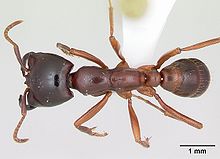Dorylinae
Appearance
| Dorylinae | |
|---|---|

| |
| D. gribodoi | |
| Scientific classification | |
| Domain: | Eukaryota |
| Kingdom: | Animalia |
| Phylum: | Arthropoda |
| Class: | Insecta |
| Order: | Hymenoptera |
| Family: | Formicidae |
| Subfamily: | Dorylinae Leach, 1815 |
| Type genus | |
| Dorylus Fabricius,1793
| |
| Diversity[1] | |
| 28 genera | |
Dorylinaeis anantsubfamily,with distributions in both theOld WorldandNew World.Bradyet al.(2014)synonymizedthe previous dorylomorph subfamilies (Aenictinae, Aenictogitoninae, Cerapachyinae, Ecitoninae, and Leptanilloidinae) under Dorylinae,[2]while Borowiec (2016) reviewed and revised the genera, resurrecting many genera which had previously been merged.[3]Dorylinae genera are suggested to have evolved sometime between102 to 74million years ago,subsequently undergoing rapidadaptive radiationevents during their early history.[2]
Genera
[edit]- AcanthostichusMayr, 1887
- AenictogitonEmery, 1901
- AenictusShuckard, 1840
- CerapachysSmith, 1857
- CheliomyrmexMayr, 1870
- ChrysapaceCrawley, 1924
- CylindromyrmexMayr, 1870
- DorylusFabricius, 1793
- EburoponeBorowiec, 2016
- EcitonLatreille, 1804
- EusphinctusEmery, 1893
- LabidusJurine, 1807
- LeptanilloidesMann, 1923
- LioponeraMayr, 1879
- LividoponeBolton & Fisher, 2016
- NeivamyrmexBorgmeier, 1940
- NeocerapachysBorowiec, 2016
- NomamyrmexBorgmeier, 1936
- OoceraeaRoger, 1862
- ParasysciaEmery, 1882
- †ProcerapachysWheeler, 1915
- SimoponeForel, 1891
- SphinctomyrmexMayr, 1866
- SysciaRoger, 1861
- TaniponeBolton & Fisher, 2012
- VicinoponeBolton & Fisher, 2012
- YunodorylusXu, 2000
- ZasphinctusWheeler, 1918
References
[edit]- ^Bolton, B.(2016)."Dorylinae".AntCat.Retrieved19 October2016.
- ^abBrady, Seán G; Fisher, Brian L; Schultz, Ted R; Ward, Philip S (2014)."The rise of army ants and their relatives: diversification of specialized predatory doryline ants".BMC Evolutionary Biology.14(1): 2–14.Bibcode:2014BMCEE..14...93B.doi:10.1186/1471-2148-14-93.PMC4021219.PMID24886136.
- ^Borowiec, M. (2016)."Generic revision of the ant subfamily Dorylinae (Hymenoptera, Formicidae)".ZooKeys(608): 1–280.Bibcode:2016ZooK..608....1B.doi:10.3897/zookeys.608.9427.PMC4982377.PMID27559303.
External links
[edit] Media related toDorylinaeat Wikimedia Commons
Media related toDorylinaeat Wikimedia Commons
